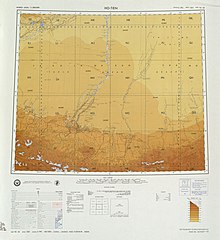Citations:Oytograk
Jump to navigation
Jump to search
English citations of Oytograk
| 1995 | 2003 2010 | ||||||
| ME « | 15th c. | 16th c. | 17th c. | 18th c. | 19th c. | 20th c. | 21st c. |

- 1995, Die Erde: Zeitschrift der Gesellschaft für Erdkunde zu Berlin[1], volume 126, →ISSN, →OCLC, pages 218–219:
- ...glaciation NE of Oytograk, today covered by star dunes, supplied the sands for the oldest dunes which had been active before (or during?)...Today, the star dunes at the southern margin near Qira and S of Oytograk have the oldest aeolian age according to granulometry, salinity and heavy-mineral content and in spite of their slight grain patina.
- 2003, Tashpolat Tiyip, Liu Chuansheng, Ding Jianli, “Extracting precaution line of the arid area environmental changes using 3S techniques”, in (Please provide the book title or journal name)[2], :
- The precaution line of 1999 has extended the trend to the northern part of the Keriya oasis, that is, the natural oasis has extended the desert in some degree,especially in the northern part of Karki village. The 1999 precaution line has a trend of local expansion in the southern part of Langan village, and this is in relation to irrigation and opening up wasteland. The 1999 precaution line is also expanding in Oytograk village in the eastern part of Keriya County and along the Keriya River, owing to the increase of the Keriya River’s flux.
- 2010, Yalikun Tashi, Philippe C. Chamard, Marie-Françoise Courel, Tashpolat Tiyip, Yiliminuer Tuerxun, Sam Drake, “The Recent Evolution of the Oasis Environment in the Taklimakan Desert, China”, in Water and Sustainability in Arid Regions[3], →ISBN, →OCLC, page 69:
- Irrigation has expanded since 1949 with the increase in cultivated land. Agricultural water consumption increased from 300 million m³ in 1949 to more than 600 million m³ in 1980. Thus Figs. 4.9, 4.10, and 4.11 show cultivated areas increased since 1977 in Oytograk (circle1), in the south of the Keriya oasis (circles 2 and 3), and in Laysu (circle 9), and the extension of cultivated lands and the irrigation system contributed to a transformation of some desert areas into oasis.
- [2023 July 13, Sirapil Mattursun, Tursungul Sawut, “Farmers are busy picking safflowers in Yutian County, Hotan Prefecture, NW China’s Xinjiang”, in Jia Shaoqi, editor, Tianshannet[4], archived from the original on 27 August 2023, Xinjiang News[5]:
- In recent years, relying on its unique location, geography, water and soil resources, Aoyituogelake Township, Yutian County, northwest China’s Xinjiang, has vigorously developed the safflower industry and injected vitality into rural economic development. […] In the garden of safflower in Tuogelawusitang Village, Aoyituogelake Township, Yutian County, safflower blossoms with a pleasant fragrance, and farmers are busy picking safflowers, which presents a vibrant scene.]
Spanish citations of Oytograk
- [2019 September 27, “Reflejan historias baja pobreza en China”, in Reforma[6], archived from the original on February 17, 2024, ENTÉRATE[7]:
- Por Bai Zhiyu, Diario del Pueblo Este año en pleno verano, la aldea Ya'ermaili, situada en el pueblo Aoyituogelake del distrito Yutian, Xinjiang, estaba cubierta de flores y frutos maduros, y la vida de la gente estaba llena de abundancia y satisfacción.
- (please add an English translation of this quotation)]